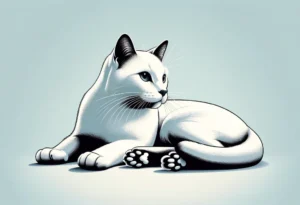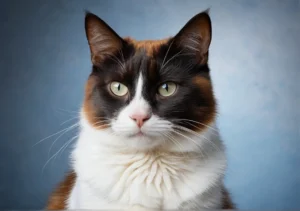Orange cats are a striking and unique sight, often catching the eye with their vibrant fur. Have you ever wondered why these colorful felines are so rare? Let’s uncover the reasons behind the scarcity of orange cats.
Genetic Factors
Orange cats are considered rare due to genetic factors that influence their coat color. One key factor is the presence of a sex-linked gene that determines whether a cat will be orange. This gene is located on the X chromosome, meaning that orange coloration is often linked to the cat’s gender.
Male cats only have one X chromosome, so if they inherit the orange gene, they will display an orange coat. This is why orange cats are more commonly male. On the other hand, female cats have two X chromosomes, so they must inherit the orange gene from both parents to be orange. This dual inheritance makes female orange cats less common and adds to their rarity.
Interestingly, this genetic link to the X chromosome also explains why calico cats are often female. Calico cats have a combination of orange, black, and white fur, with the orange color linked to the same gene responsible for orange cats. Therefore, the unique genetic makeup of orange cats contributes to their rarity in the feline world, making them stand out among their peers.
Calico Connection
The connection between orange cats and calico cats runs deep, shedding light on why orange cats are a rare sight. Calico cats are known for their beautiful tricolor coats, including patches of orange, black, and white fur. What makes this connection interesting is that the orange color in calico cats is also tied to the same sex-linked gene responsible for orange cats.
Female calico cats, with their patchwork coats, typically inherit one X chromosome carrying the orange gene, leading to the orange patches in their fur. This intricate genetic interplay between the X chromosome and coat coloration not only adds to the beauty of calico cats but also contributes to the rarity of orange cats.
The rarity of orange cats is further emphasized by the fact that male calico cats are extremely uncommon due to the genetic requirements for their unique coloring. This correlation between orange cats and calico cats underscores the complex nature of feline genetics and offers a fascinating glimpse into the diverse world of cat coat colors.
Rescue Shelters
Orange cats are not particularly rare, but they do tend to have a lower population in rescue shelters compared to their more common counterparts. This can be attributed to several factors, such as the perceived popularity of orange cats leading to them being adopted more quickly than other colors. Additionally, the striking appearance of orange cats might make them more noticeable and therefore more likely to be adopted sooner.
On the other hand, black cats, despite being just as lovable and deserving of forever homes, are sometimes overlooked due to superstitions surrounding them. The belief that black cats are bad luck or associated with witchcraft can lead to them spending more time in shelters without being adopted, contributing to the high population of black cats in these facilities.
Unique Insight: One way to help address this disparity is to actively promote the adoption of orange cats through outreach programs and social media campaigns. By highlighting the unique qualities of orange cats and dispelling any misconceptions about them, more people may be inclined to consider adopting an orange cat, ultimately helping to balance out the population in rescue shelters.
Black Cat Superstitions
Black cats have long been associated with superstitions, particularly in Western cultures where they are often seen as symbols of bad luck. This superstition dates back to the Middle Ages when black cats were believed to be companions of witches and bringers of misfortune. While these beliefs are largely unfounded, they continue to impact the adoption rates of black cats today.
In contrast, orange cats are not typically subject to the same superstitions, which may contribute to their higher adoption rates and lower prevalence in rescue shelters. By challenging and educating the public about the myths surrounding black cats, we can help increase their chances of finding loving homes and reduce their overrepresentation in shelters.
To help combat this stigma, shelters can actively promote black cats through special adoption events, social media campaigns, and educational programs. By showcasing the lovable personalities of black cats and debunking common misconceptions, more people may be encouraged to consider adopting these often overlooked feline companions.
Remember, at the end of the day, a cat’s color shouldn’t determine their worth or the love they have to offer. All cats, regardless of color, deserve a chance at a happy and fulfilling life with a loving family.
Famous Orange Cats
Let’s talk about some iconic orange cats that have made a mark in history and pop culture. Garfield, the lazy yet lovable comic strip cat created by Jim Davis, is perhaps the most well-known orange feline. With his sarcastic humor and love for lasagna, Garfield has captured the hearts of many around the world. Another famous orange cat is Milo from the classic movie “Milo and Otis,” whose adventurous spirit and friendship with a pug named Otis warmed audiences’ hearts. Additionally, Simba from Disney’s “The Lion King” is a notable orange cat, though he’s a lion. Despite not being a traditional house cat, Simba remains a beloved and iconic character in the world of animation.
Health Considerations
When it comes to orange cats, there’s an interesting genetic factor that contributes to their rarity. The gene responsible for their orange coat color is located on the X chromosome. As a result, male cats need only one copy of the orange gene to display the orange coat color, while female cats need two copies. This genetic quirk means that orange cats are more commonly male, making them less common overall. It’s important to note that while the rarity of orange cats adds to their unique charm, it doesn’t necessarily impact their health or well-being. In fact, orange cats are just as healthy and lively as cats of any other color.
Here is a list of potential health considerations that may be associated with the genetics of orange cats: – Increased likelihood of male gender: Orange cats are more likely to be male due to the genetic factors that determine their coat color. – Potential for sunburn: Because orange cats lack the protective pigment found in darker coats, they may be more prone to sunburn if they spend long hours outdoors. Ensure your orange cat has access to shade and consider using pet-safe sunscreen if needed.
By understanding these genetic factors and potential health considerations, you can ensure that your orange cat leads a happy and healthy life.
Cultural Significance
Orange cats have been symbols of good luck and prosperity in various cultures around the world. In Japan, they are believed to bring financial success and wealth, while in Egypt, they were considered sacred and worshipped for their connection to the sun god Ra. Additionally, orange cats are often associated with warmth, energy, and creativity in many Western cultures. This cultural significance has contributed to the popularity of orange cats in art, literature, and folklore throughout history.
Breeding Programs
Breeding programs play a vital role in maintaining and potentially increasing the population of orange cats. Through selective breeding, breeders can promote the genetic traits that produce orange fur, such as the presence of the “orange” gene (O gene). By carefully pairing orange cats with suitable mates, breeders can ensure a higher likelihood of producing orange offspring. While breeding programs can help sustain the population of orange cats, it is essential to prioritize the health and well-being of the cats to prevent any negative impacts on their overall welfare.
Additionally, here are some factors affecting the rarity of orange cats: 1. Genetics: The orange fur color is a result of specific genetic factors, making orange cats less common than other coat colors. 2. Color Preferences: Some people may have preferences for other coat colors, leading to fewer orange cats being bred. 3. Natural Selection: In the wild, orange cats may be more susceptible to predators due to their bright color, potentially impacting their overall population size. 4. Geographic Location: The prevalence of orange cats may vary depending on the region, with some areas having a higher concentration of orange cats than others.
Fun Facts
Did you know? Orange cats are more likely to be male than female due to the genetic makeup that determines fur color. In fact, about 80% of orange cats are male!
Fun Fact: The orange fur color in cats is caused by a specific gene called the “O” gene, which is responsible for producing the orange pigment known as pheomelanin.
Interesting Tidbit: Some orange cats are also known as “marmalade cats” due to their resemblance to the color of marmalade.
Unique Insight: Orange cats are often considered to be friendly and outgoing, with many owners describing them as having vibrant and playful personalities.
Mythbusting
Myth: Orange cats are always male.
Fact: While the majority of orange cats are male, there are also female orange cats. The gene responsible for orange fur is located on the X chromosome, so female cats can have orange fur if they inherit two copies of the orange gene.
Debunked: Another common myth is that orange cats are more aggressive compared to cats of other colors. In reality, temperament is not determined by fur color but by a variety of factors including genetics, socialization, and individual personality traits.
Myth: Orange cats are rare because of their color.
Fact: The rarity of orange cats is due to the genetics behind the orange fur color, not the color itself. The gene for orange fur is recessive, so both parents must carry the gene to produce an orange kitten.
Quick Tip: When adopting a cat, remember that personality and compatibility are more important than coat color. Orange cats can make wonderful companions regardless of their color!
Check out this interesting article by National Geographic for more information on the genetics of orange cats.
Conservation Efforts
Orange cats, while not necessarily rare in domestic settings, may face challenges in the wild due to habitat destruction and human interference. Conservation efforts to protect and preserve the population of orange cats primarily focus on promoting responsible pet ownership to prevent them from straying into dangerous environments. Organizations such as the American Society for the Prevention of Cruelty to Animals (ASPCA) and local animal shelters work to educate the public on the importance of spaying and neutering cats to control the population and prevent the spread of diseases. By promoting adoption over buying from breeders, these organizations aim to reduce the number of abandoned orange cats and provide them with loving homes.
Behavioral Traits
Orange cats are often associated with unique behavioral traits that set them apart from other colored felines. Studies suggest that orange cats tend to be more affectionate and sociable, forming strong bonds with their human companions. They are known for their playful and outgoing nature, often seeking attention and engaging in interactive play. Additionally, orange cats are believed to have a higher tolerance for handling and grooming compared to cats of other colors. Their friendly and curious personalities make them popular choices for families looking for a loving and interactive pet.
- Independent Nature: Despite their affectionate demeanor, orange cats also exhibit an independent streak, enjoying their alone time and exploring their surroundings with confidence.
- Communication Skills: Orange cats are often vocal and expressive, using a variety of meows, purrs, and body language to communicate their needs and desires.
By understanding these unique traits, orange cat owners can provide their feline companions with the care and attention they need to thrive.
Alex, a passionate animal lover, has experience in training and understanding animal behavior. As a proud pet parent to two dogs and three cats, he founded AnimalReport.net to share insights from animal experts and expand his knowledge of the animal kingdom.




